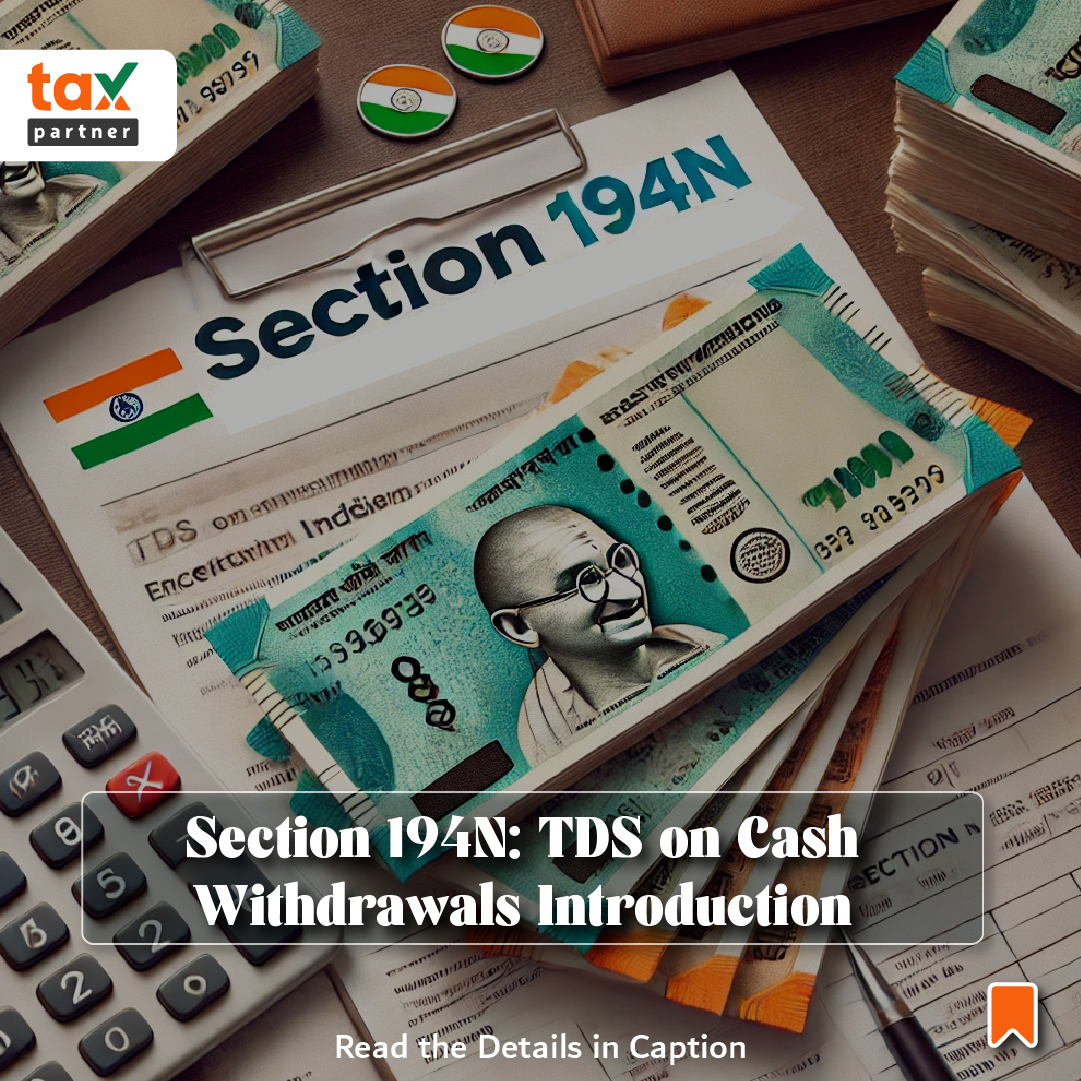Connect with us for all your queries



In a move aimed at curbing the prevalence of cash transactions and promoting a digital economy, the Indian government introduced Section 194N in the Income Tax Act, 1961. This provision, first brought into effect in the Union Budget of 2019, mandates the deduction of Tax Deducted at Source (TDS) on cash withdrawals exceeding a specified limit within a financial year. With an increasing emphasis on transparency in financial dealings and a robust tax collection mechanism, Section 194N serves as a critical tool in the government's efforts to monitor and regulate large cash transactions.
For taxpayers, businesses, and financial institutions, understanding the intricacies of Section 194N is essential for ensuring compliance with tax laws and avoiding potential penalties. This article aims to provide a detailed analysis of the provision, including its applicability, exemptions, compliance requirements, and the broader implications for the Indian economy. By the end of this comprehensive guide, readers will have a thorough understanding of how Section 194N operates, its impact on various stakeholders, and practical steps to ensure adherence to its provisions. Whether you are a business owner, financial professional, or an individual taxpayer, this article will help you navigate the complexities of TDS on cash withdrawals and align your financial practices with the latest regulatory standards.
Section 194N was introduced to deter the use of cash for large transactions, which often escape the scrutiny of tax authorities. The provision is straightforward yet far-reaching in its implications. It mandates that any person, including individuals, Hindu Undivided Families (HUFs), companies, firms, or other entities, who withdraws cash exceeding a certain threshold from their bank accounts, must have TDS deducted on the amount above the specified limit.
The applicability of Section 194N is broad, covering various types of entities and financial institutions. Specifically, the provision applies to withdrawals from:
Banks: Including both public and private sector banks.
Co-operative Societies Engaged in Banking: These societies are treated similarly to regular banks under this provision.
Post Offices: Withdrawals from post office savings accounts are also subject to Section 194N.
The TDS under Section 194N is applicable when the total cash withdrawals exceed ₹1 crore in a financial year. However, the Finance Act, 2020 introduced a lower threshold of ₹20 lakhs for specific cases. The applicable TDS rates based on the withdrawal amount and the taxpayer's filing history are as follows:
For Regular Filers:
If cash withdrawals exceed ₹1 crore in a financial year, TDS is deducted at 2% on the amount exceeding ₹1 crore.
For Non-Filers:
If the taxpayer has not filed their income tax returns for the previous three financial years, TDS is deducted at:
2% on cash withdrawals exceeding ₹20 lakhs but up to ₹1 crore.
5% on cash withdrawals exceeding ₹1 crore.
To balance the need for regulation with practical considerations, the government has exempted certain entities from the purview of Section 194N. These exemptions ensure that essential services and public institutions are not unduly burdened by TDS provisions. The exempt entities include:
Government Bodies: Central and State governments are exempt from TDS on cash withdrawals.
Banking Companies: Banks, including co-operative banks, are exempt from TDS when they withdraw cash for their operational purposes.
Post Offices: Cash withdrawals by post offices for their functions are not subject to TDS under this section.
Business Correspondents: Business correspondents of banking companies or co-operative societies are exempt from TDS when withdrawing cash on behalf of the bank.
White Label ATM Operators: These operators, who manage ATMs under a contract with banks, are also exempt from the TDS provisions of Section 194N.
The primary objective behind the introduction of Section 194N is to curb the flow of unaccounted money and reduce the reliance on cash transactions, which are often outside the formal economy's purview. Large cash withdrawals are typically associated with tax evasion, money laundering, and other financial malpractices. By imposing TDS on such withdrawals, the government aims to bring more transparency and accountability into the financial system.
Furthermore, the government’s broader agenda of promoting digital transactions aligns with the objectives of Section 194N. By disincentivizing large cash withdrawals through TDS, the provision encourages individuals and businesses to adopt digital payment methods, which are easier to track and regulate.
The introduction of Section 194N has significant implications for both businesses and individuals, especially those operating in cash-intensive sectors. Below, we explore the impact on different stakeholders:
For businesses, especially in sectors like retail, real estate, construction, and hospitality, cash transactions have historically been the norm. However, with the introduction of Section 194N, these businesses now face an additional tax burden if they exceed the specified withdrawal limits. This has prompted many businesses to reconsider their cash management strategies and explore alternative payment methods such as digital transfers and cheques.
Moreover, businesses that have not been regular in filing their income tax returns face a lower threshold limit of ₹20 lakhs, which could significantly impact their cash flow if not managed carefully. The 5% TDS rate for withdrawals exceeding ₹1 crore is particularly steep, further incentivizing businesses to maintain proper tax compliance to avoid the additional financial burden.
Individuals, particularly those who are not regular tax filers, also feel the impact of Section 194N. For such individuals, the lower threshold of ₹20 lakhs and the higher TDS rate of 5% serve as strong deterrents against large cash withdrawals. This provision essentially pushes individuals towards regularizing their tax filings or adopting more formal banking channels for their financial transactions.
For individuals who regularly withdraw large sums of cash, such as those engaged in certain trades or professions, Section 194N necessitates a shift in how they conduct their transactions. It encourages them to limit their cash withdrawals or face the consequences of higher TDS, thereby indirectly promoting greater participation in the digital economy.
Understanding how TDS is calculated under Section 194N is crucial for businesses and individuals to avoid unnecessary tax deductions. The TDS is calculated on the amount exceeding the specified threshold limit. Below are a few examples to illustrate the calculation process:
If a taxpayer who has filed their income tax returns for the previous three years withdraws ₹1.5 crore in a financial year, the TDS is calculated as follows:
Total Withdrawal: ₹1.5 crore
Threshold Limit: ₹1 crore
Excess Amount: ₹50 lakhs (₹1.5 crore - ₹1 crore)
TDS Rate: 2%
TDS Amount: ₹1 lakh (2% of ₹50 lakhs)
For a taxpayer who has not filed income tax returns for the last three years and withdraws ₹60 lakhs in a financial year, the TDS is calculated as follows:
Total Withdrawal: ₹60 lakhs
Threshold Limit: ₹20 lakhs
Excess Amount: ₹40 lakhs (₹60 lakhs - ₹20 lakhs)
TDS Rate: 2%
TDS Amount: ₹80,000 (2% of ₹40 lakhs)
If the same non-filer withdraws ₹1.2 crore in a financial year, the TDS is calculated in two parts:
For the amount between ₹20 lakhs and ₹1 crore:
Excess Amount: ₹80 lakhs (₹1 crore - ₹20 lakhs)
TDS Rate: 2%
TDS Amount: ₹1.6 lakhs (2% of ₹80 lakhs)
For the amount exceeding ₹1 crore:
Excess Amount: ₹20 lakhs (₹1.2 crore - ₹1 crore)
TDS Rate: 5%
TDS Amount: ₹1 lakh (5% of ₹20 lakhs)
Total TDS: ₹2.6 lakhs (₹1.6 lakhs + ₹1 lakh)
To ensure compliance with Section 194N, entities making cash withdrawals must maintain proper records and regularly monitor their withdrawal amounts. Banks and financial institutions are required to check the income tax return filing status of the person withdrawing cash to determine the applicable TDS rate. This involves verifying whether the person has filed returns for the previous three years and calculating the cumulative withdrawals across all accounts.
Additionally, the deductor is responsible for depositing the TDS amount with the government within the stipulated time frame and issuing a TDS certificate to the deductee. The deductee can claim credit for the TDS while filing their income tax return, reducing their overall tax liability.
While Section 194N has been instrumental in promoting a less-cash economy, it has also faced some criticism. Small businesses and rural populations, who rely heavily on cash transactions due to limited access to digital infrastructure, may find this provision burdensome. The additional tax burden on cash withdrawals can impact their cash flow and operational efficiency.
Moreover, the requirement to file income tax returns for three consecutive years to avoid a higher TDS rate may pose challenges for individuals and entities with irregular income or those new to the tax system. These groups may be compelled to limit their cash withdrawals or face higher tax deductions, potentially affecting their financial activities.
Since its introduction, Section 194N has undergone several amendments to enhance its effectiveness and address practical challenges. The reduction of the threshold limit from ₹1 crore to ₹20 lakhs for non-filers is one such amendment aimed at bringing more individuals and businesses under the tax net.
The government continues to refine this provision based on feedback and evolving economic conditions. It is essential for taxpayers and financial institutions to stay updated with any changes to ensure compliance and avoid penalties.
Section 194N of the Income Tax Act, 1961, represents a significant move by the government towards curbing cash transactions and promoting digital payments. By imposing TDS on large cash withdrawals, the provision discourages the use of unaccounted money and ensures that more transactions are conducted within the formal banking system.
While the provision has brought greater transparency and accountability in financial transactions, it also presents challenges, particularly for small businesses and rural populations. As the government continues to refine this provision, it is crucial for businesses and individuals to adapt to the changing landscape and explore alternative payment methods that align with the goal of a less-cash economy.
Taxpayers must remain vigilant in managing their cash withdrawals and ensuring compliance with Section 194N to avoid unnecessary tax burdens and penalties. By understanding the implications of this provision and incorporating digital payment methods into their operations, businesses and individuals can contribute to a more transparent and accountable financial system.
Tax Partner is India’s most reliable online business service platform, dedicated to helping you in starting, growing, & flourishing your business with our wide array of expert services at a very affordable cost.